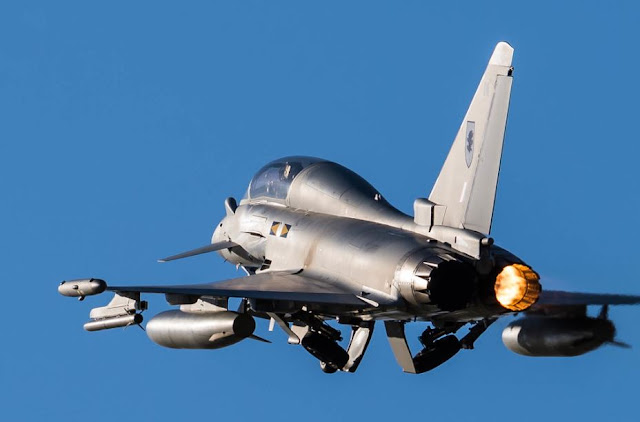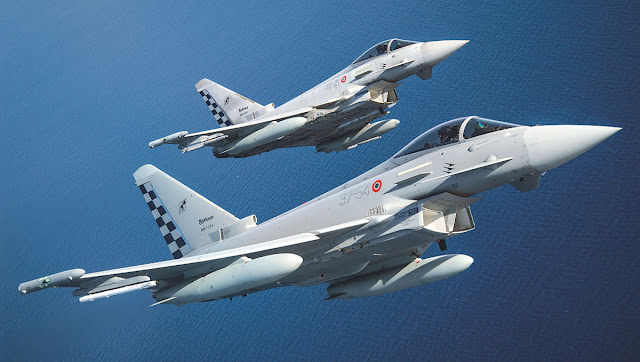Lee Wilson
by Jon Lake - February 10, 2022, 8:00 PM
Italy is the nominated lead partner nation for the Typhoon campaign in Bangladesh, although the UK has also signaled its strong support for the bid. (Photo: Eurofighter/Giovanni Colla)
Bangladesh has a requirement for 16 new multirole combat aircraft (MRCA) to augment and eventually replace its aging Chengdu F-7s and MiG-29s, and the nation wants to turn westward after decades of purchasing its fighter aircraft from Russia and China. The impetus for the shift came in 2015, with the appointment of a new Chief of the Air Staff, Air Chief Marshal Abu Esrar, who wanted to phase out the Bangladesh Air Force fleet of Russian and Chinese fighters and replace them with Western aircraft. Esrar evaluated the Eurofighter Typhoon at the 2016 Farnborough International Airshow and he reportedly “fell in love with it.” Esrar’s successor, Air Chief Marshal Masihuzzaman Serniabat, appears equally enthusiastic, though a planned evaluation with Leonardo fell victim to the Covid pandemic.
Bangladesh’s Directorate General Defence Purchase (DGDP) launched a tender in 2017 for the purchase of eight fighters, plus options for an additional four, under the Forces Goal 2030 program. Later increased to 16 aircraft, the tender calls for a new-build, twin-engine fighter, with each engine producing at least 12,125 pounds of dry thrust and over 17,635 pounds with afterburner. The minimum payload will be five tonnes with at least eight weapons hardpoints. Additional stipulations call for the new fighter to come with active electronically-scanned array (AESA) radar with an air-to-air range of 93 miles and an air-to-surface range of 31 miles, an infrared search and track (IRST) system, and an integrated electronic warfare (IEW) and electronic countermeasures (ECM) suite.
Bangladesh now fields a modest force of about 44 fighter aircraft, consisting of eight MiG-29s and MiG-29UBs assigned to No. 8 Squadron at Kurmitola (Bangabandhu airbase), the military enclave of Dhaka International Airport, and the survivors of 28 Chengdu F-7BGs and four FT-7BGs assigned to Nos. 5 and 35 Squadrons at the same location. Some 16 older F-7MB and eight FT-7MB aircraft have retired from service. Four of the MiG-29s were updated to MiG-29BM/UBM standards in Belarus between 2019 and 2020 and the remaining four are expected to follow, but they are no match for modern 4.5 generation fighters, while the F-7s are verging on obsolescence.
Under the 2009 Bangladesh Armed Forces Forces Goal 2030 modernization program, the Bangladesh Air Force received 16 Yak-130 advanced jet trainer and light combat aircraft ordered in 2013, and planned to purchase eight Sukhoi Su-30SME aircraft in 2017. Relations with Moscow soured after it supported Myanmar over the Rohingya issue, however, and worsened after Russia agreed to sell the Yak-130 and Su-30 to Myanmar. Dhaka also did not like Moscow’s stipulation that it should buy MiG-35s along with the Su-30, and began seeking a new solution.
Accordingly, the Bangladesh Air Force asked the government to earmark around 25,200 Crore Taka ($3 billion) for 16 Western multi-role fighters with an advance of 6,300 Crore Taka for the financial year 2021-22. That will allow the Bangladesh Air Force to seek a complete package with aircraft, support, training, and a variety of weapons. It must also include the creation of a maintenance, repair, and overhaul (MRO) facility in the country.
Quite apart from the difficulties experienced by Dhaka in reaching an agreement on the Su-30, senior Bangladeshi officers felt that the aircraft would not provide sufficient operational advantage or overmatch because the Su-30 remains the mainstay of regional rivals India and Myanmar. Since the Bangladesh Air Force is so much smaller than those of potential foes it needs to achieve a favorable exchange ratio to impose a sufficiently heavy cost to deter any aggression. Using the same aircraft type would make that harder to achieve.
Western fighters carry significant advantages over Russian and Chinese types, and the Saab Gripen and Lockheed Martin F-16 reportedly have been offered and considered, though Bangladesh now plans to acquire more capable twin-engined fighters. The Dassault Rafale (in service with the Indian Air Force, which could be a drawback) and the Eurofighter Typhoon stand as the aircraft under consideration.
Although Italy is the Eurofighter partner designated to market the aircraft in Bangladesh, it seems likely that the UK also would support any formal campaign. The report following the third Bangladesh-UK strategic dialogue in 2019 stated: “The UK further expressed its readiness to support Bangladesh with procurement of high-caliber multi-role combat aircraft alongside other modernization programs."
Many in the Dhaka defense establishment believe that the Eurofighter Typhoon could give Bangladesh the capability edge it needs and could provide the deterrent capability it has lacked since the country became independent in 1971. For the Bangladesh Air Force, operating the Typhoon would provide a useful route toward forging relationships with the four high-tech Eurofighter partner nations and their air forces, and could provide opportunities to operate and train with the four GCC air arms that also fly the Typhoon.
Eurofighter Typhoon: Details


No comments:
Post a Comment